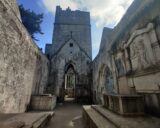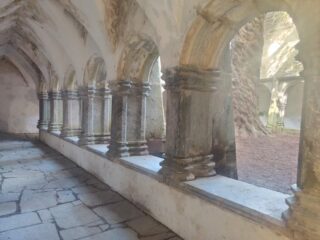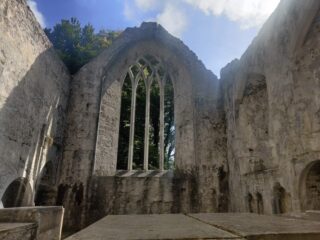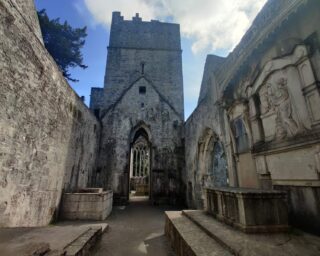Notice
Muckross Abbey is a National Monument in state guardianship
WARNING: It should be noted that these sites are unguided and a level of care and caution should be maintained during all stages of your visit. The Office Of Public Works (OPW) will not be held responsible for any damages, injuries, or losses that occur
Muckross Franciscan Friary
Muckross Abbey (Mainistir Locha Léinand Mainistir Mhucrois) was founded in 1448 by the Observantine faction of the Franciscan Order, with the political support and financial patronage of the Gaelic Irish Chieftain Donal Mac Mór Mac Chartaigh (Donal McCarthy Mor).
Though known as “Muckross Abbey” the building was in fact a “Friary” not an Abbey. Abbey’s, like the nearby monastery on Innisfallen Island, were built for the monks to live in, in isolation from society, leading a secluded contemplative life of prayer. However the Franciscan Friars living in this friary would regularly have travelled to nearby towns to preach to the local people and lived as a ‘mendicant order’ having their food and supplies donated to them by local people, including the powerful McCarthy Clan.
The friary is of a typical Franciscan design consisting of a large church divided into a nave for the congregation at the western end and a chancel at the eastern end where mass was said at an altar. A bell tower was constructed marking a boundary between these two areas; and it may also have originally had a wooden “rood screen” installed beneath it. To the south of this there is a transept for private prayer which would probably have had statues and side altars dedicated to St. Francis or Mary the mother of Christ. Adjoining the North side of the church there is a cloister where the friars would have walked in meditative prayer. Today, a yew tree still stands at the centre; this is thought to be one of the oldest in Ireland, as it is likely up to 400 years old. In 1756, one of the first tourists to Killarney, the Englishman Charles Smith, wrote that it was one of the tallest yew trees he had ever seen: “Its spreading branches, like a great umbrella, overshadow the niches of the great cloister.’’ (Unsurprisingly there is a great wealth of folklore still surviving about the tree and supernatural harm that strikes down anyone who interferes with it.) Bordering the cloister are a chapter house/dormitory where the friars ate and lived, a kitchen, a sacristy/vestry, a refectory, and the Prior’s House where the head of the Franciscan chapter at Muckross lived.
Muckross Friary was sacked by the English forces of Elizabeth I during the Desmond Rebellions of the late 16th century. In 1652 a unit of Cromwell’s New Model Army, under the command of an English General named Edmond Ludlow, raided the friary and removed its roof to render it uninhabitable. A number of the Franciscans were killed in this attack, the survivors fled to France as refugees, and the buildings were left abandoned. The Gaelic Irish chieftain, poet and rebel Piaras Feiritéar (1600 – 1653), who was a leading figure in the Irish Confederacy Rebellion of 1641, was executed by the English at Killarney in 1653, and is buried at Muckross Abbey. In the 17th and 18th centuries Muckross Abbey became the burial place for the last of the great Gaelic Irish poets from Kerry most notably Aodhagán Ó Rathaille (c.1670–1726) and Eoghan Rua Ó Súilleabháin (1748 – 1784). The most prominent grave inside Muckross Abbey today is that of Neilus O’Leary, an IRA leader who fought in the War of Independence and who died shortly after the Civil War ended in the late 1920s.
Visit Historic Environment Viewer for more information on Muckross Franciscan Friary
Protect our Past - Click here to read about the importance of protecting our country’s unique heritage sites
This national monument is protected in accordance with the National Monuments Acts 1930 to 2014
Gallery
Nearby sites to visit
Ross Castle
A lakeside citadel steeped in legend
Approx. 3.0 km from Muckross Franciscan Friary
Ilnacullin – Garinish Island
An island garden of rare beauty
Approx. 32.4 km from Muckross Franciscan Friary
Ardfert Cathedral
A trio of medieval churches devoted to St Brendan
Approx. 38.9 km from Muckross Franciscan Friary
Listowel Castle
The last bastion of the Fitzmaurices
Approx. 46.5 km from Muckross Franciscan Friary
Daniel O’Connell House – Derrynane House
The childhood home of Daniel O’Connell
Approx. 52.6 km from Muckross Franciscan Friary
Desmond Castle Newcastlewest
Where sounds of medieval revelry echo around the walls
Approx. 55.7 km from Muckross Franciscan Friary




